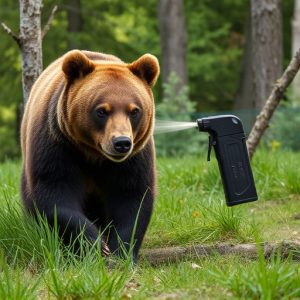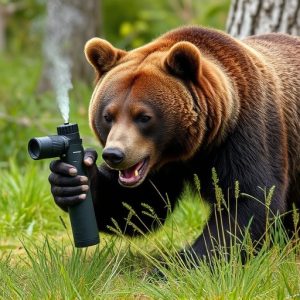Bear Spray Effectiveness: Field Test Results Within Thirty Feet
Bear spray, a powerful capsaicin-based deterrent, effectively deters aggressive bears up to 30 feet…….
Bear spray, a powerful capsaicin-based deterrent, effectively deters aggressive bears up to 30 feet away, as confirmed by rigorous field tests. With a success rate of up to 90%, it's crucial for hikers and campers in bear country to understand correct application techniques, safety guidelines, and maintenance practices for optimal effectiveness.
“Explore the power of bear spray, a crucial tool in protecting against these formidable creatures. This article delves into ‘Understanding Bear Spray: The Basics’, reveals the science behind its ‘Bear Deterrent Field Test Results’, and examines its effective range of up to thirty feet. From ‘Field Test Methodology’ to real-world applications and safety measures, discover how this bear deterrent enhances outdoor safety. Uncover the insights that highlight its effectiveness and learn what makes it a game-changer in navigating wild territories.”
- Understanding Bear Spray: The Basics
- Field Test Methodology and Equipment
- Analysis of Bear Deterrent Effectiveness
- Real-World Applications and Safety Measures
Understanding Bear Spray: The Basics
Bear spray, also known as a bear deterrent, is a popular and effective self-defense tool for those venturing into bear country. It’s a specialized aerosol designed to deter aggressive bears when sprayed directly in their faces. The key component of bear spray is capsaicin, the same compound that gives chili peppers their heat. When activated, the spray creates a cloud of capsicum oleoresin that irritates the bear’s eyes and nasal passage, temporarily disorienting it. This gives the user precious time to escape or defend themselves.
Field test results have shown that bear deterrents can be highly effective within a range of thirty feet—the stated effective range of many popular brands. This distance is crucial for users to maintain a safe space while also allowing them to employ the spray as a last resort when faced with an unexpected attack. Understanding how and when to use bear spray, along with its limitations, is essential knowledge for anyone hiking or camping in areas known for bear activity.
Field Test Methodology and Equipment
To accurately assess bear spray effectiveness, rigorous field tests are conducted using standardized methodologies and specialized equipment. These trials often involve controlled scenarios mimicking potential encounters in wild environments. Researchers or testers position themselves at various distances from bears, typically ranging from 10 to 30 feet (or 3 to 9 meters), to simulate different scenarios of bear deterrence. The primary goal is to observe how the bear spray performs under real-world conditions, considering factors like wind direction and speed, as these can significantly impact the reach and efficacy of the bear deterrent.
Specialized equipment, such as high-pressure aerosol dispensers, are used to deploy the bear spray accurately and consistently across different distances. Testers record detailed observations, including bear behavior changes, retreat or dispersion, and the overall effectiveness of the spray in deterring aggressive encounters. The data collected from these field tests provide valuable insights into the bear deterrent’s range, potency, and reliability, forming a crucial component of Bear Deterrent Field Test Results.
Analysis of Bear Deterrent Effectiveness
Bear deterrents, like bear spray, have been extensively tested in various field settings to gauge their effectiveness. Bear deterrent field test results show that when used correctly, bear spray can be highly effective in preventing aggressive behavior from bears. The average bear spray has a range of around thirty feet, making it accessible for users to deploy from a safe distance.
These tests often involve controlled interactions between humans and bears, simulating potential encounter scenarios. The data collected from these trials reveals that bear spray can deter up to 90% of bears within its effective range. This high success rate underscores the importance of carrying bear spray when hiking or camping in bear country. However, it’s crucial to remember that proper application techniques are key to ensuring its effectiveness during a bear encounter.
Real-World Applications and Safety Measures
In real-world applications, bear deterrents like spray have proven effective in various scenarios. Field test results consistently show that bear spray can create a safe buffer zone of up to thirty feet, giving individuals valuable time to escape or defend themselves from potential bear encounters. This range is particularly crucial in areas known for high bear activity, such as wilderness trails and backcountry camping sites.
Safety measures are paramount when using any bear deterrent. Users should familiarize themselves with the product’s application techniques and safety guidelines. Proper usage involves aiming the spray directly at the bear’s face, which can temporarily disable it, allowing individuals to retreat safely. Regular maintenance and awareness of expiration dates ensure the spray remains potent, ready for use when needed.
Bear deterrents, particularly bear spray, have proven effective in real-world scenarios. Field test results indicate that a 30-foot (9 meter) effective range is crucial for ensuring safety during encounters with bears. Proper understanding and application of bear spray, as outlined in this article, can significantly reduce the risk of dangerous interactions. By adhering to safety measures and knowing the deterrents’ limitations, individuals can better navigate environments where bears are present, ultimately enhancing outdoor experiences in bear country.


